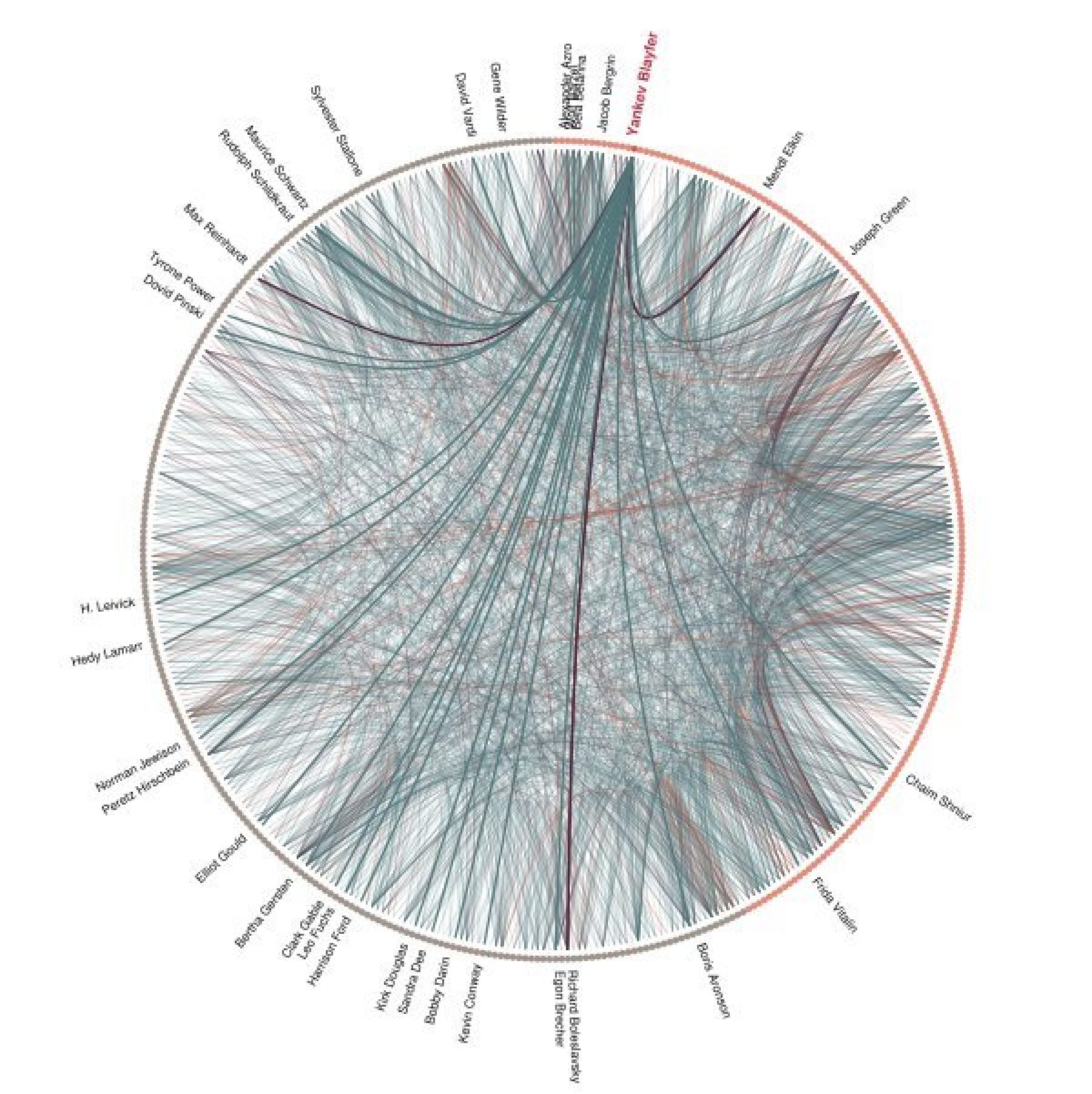
Visualization of Blayfer’s connections.
Six Degrees of Yankev Blayfer
Debra Caplan
Yankev Blayfer. Sonia Alomis. Leola Vendorf. Baruch Lumet. Wolf Barzel. Who are these figures and what is their place in history? Their names don’t appear in any theatre history or reference work. They don’t even have Wikipedia entries. In fact, these figures are almost entirely absent from the historical record. Google their names and you will find a few IMDB and IBDB references for minor roles, and perhaps a mention or two in an obscure memoir.
And yet — Yankev Blayfer studied with Max Reinhardt and performed alongside Harrison Ford, Sylvester Stallone, Kirk Douglas, Clark Gable, and Hedy Lamarr. Sonia Alomis was close friends with actress Sophie Tucker and violinist Jascha Heifetz.
Leola Vendorf acted alongside Jack Nicholson, Cary Grant, Doris Day, Gene Kelly, and Leonard Nimoy. Baruch Lumet worked closely with Woody Allen and Jerome Robbins, discovered Jayne Mansfield, and got his son, Sidney Lumet — later a giant of American cinema — his first acting gig.
Wolf Barzel acted under Sanford Meisner and Lee Strasberg, and performed with Ethel Barrymore, Natalie Wood, and Stella Adler. Even more significantly, Barzel inspired the careers of his niece Judy Graubart and nephew Manny Azenberg. Wearing his signature purple pants and a black beret, Barzel would take Graubart and Azenberg backstage; inspired by their uncle’s bohemian lifestyle, the siblings pursued theatrical careers as a producer and comedian, respectively. Judy Graubart went on to star in the The Electric Company with Morgan Freeman, Rita Moreno, and Bill Cosby and to marry actor Bob Dishy. Manny Azenberg became a major producer who produced nearly every Neil Simon play since 1972, along with dozens of other Broadway productions. In 2012, Azenberg received a lifetime achievement Tony for his contributions to the American stage.
“Wolfie was the inspiration for everyone in the family to go into the entertainment business,” Azenberg told me over coffee in the now defunct Cafe Edison last year, “because who would have thought of it otherwise?”
By any measure, these figures — little-known as their names may be now — played a significant role in theatre and film history. Their impact stretched far beyond the scope of their shared starting point: the Yiddish theatre.
In fact, Yiddish theatre was a pivotal node for a vast global network that included many of the most central figures in the history of modern theatre and film. Stanislavsky, Meyerhold, Stella Adler, Leon Schiller, Max Reinhardt, David Belasco, Harold Clurman, Eugene Ionesco, and hundreds of others worked alongside, were related to, were friends with, or were inspired by encounters with Yiddish theatre artists.
These interpersonal connections may have vanished from the history books, but if one looks carefully enough, their traces remain: in cast lists, in theatre programs, in records of letters written and received, on invitation lists to weddings and registers for funerals, in actors’ memoirs, and in the memories of surviving actors and their kin. Collecting data from these sources reveals how Yiddish actors like Barzel, Alomis, Blayfer, Vendorf, Lumet, and hundreds of others, who scarcely appear in the annals of history, had a significant impact far beyond their contributions to Jewish culture.
To demonstrate this point, I’ve created a visualization of the personal and professional relationships of a single group of Yiddish theatre artists – the members of the Vilna Troupe, an experimental Yiddish theatre company that became a global sensation between 1915 and 1936. I compiled a dataset about the 289 Yiddish theatre artists who were members of this company using a range of sources: programs and theatrical ephemera found in archival collections at the YIVO Institute for Jewish Research, the Harvard Library Judaica Division, the Billy Rose Theater Division and the Dorot Jewish Division of the New York Public Library, and the Columbia University Jewish Studies Collection; Zalmen Zylbercweig’s 7-volume encyclopedia Leksikon fun yidishn teater (Lexicon of the Yiddish Theatre), the Internet Movie Database, the Internet Broadway Database, and interviews I personally conducted with the descendants of these actors.
The data that I compiled documents the Vilna Troupe members’ familial, artistic, and interpersonal connections to other artists, writers, musicians, and figures of import over the course of their lifetimes – i.e. a kind of social networking for the historical Yiddish stage. If Yiddish theatre artists had had Facebook in the 1920s, it would have looked something like this.
You can play with different filters to see how the members of the Vilna Troupe were connected to each other and to other artists whom they encountered. One way to start is by exploring one kind of relationship at a time: family, friendships, influences, professional connections, etc. Add and subtract filters to examine subsets of the data. To what extent was the Troupe a family affair? How did the Vilna Troupe’s professional network function for women? Which branches were most influential? How was the Vilna Troupe connected to significant figures in the fields of theatre, film, literature, and visual art? Use the filters to pose these questions, and more.
Applying data visualization to the social networks of the Vilna Troupe reveals this single company’s buried legacy. Echoes of the Vilna Troupe style and repertoire continue to resound in the work of thousands of artists who were trained, directly or indirectly, under those who spent their formative years working alongside Vilna Troupe actors – including influential artists and teachers like Stella Adler, Richard Boleslavsky, and Boris Aronson.
Mapping the Vilna Troupe’s social network by tracing its members’ relationships with other theatre practitioners renders connections between artists newly visible. Want to know how Fred Astaire, Jack Nicholson, Kirk Douglas, and Kevin Conway were connected to the Yiddish theatre? Look no further.
And for those fans of the Six Degrees of Kevin Bacon parlor game who are keeping track? Yankev Blayfer’s Bacon number is two (he’s listed under John Bleifer, the Americanized name he assumed for Hollywood).

Visualization of Blayfer’s connections.
You can play with different filters to see how the members of the Vilna Troupe were connected to each other and to other artists whom they encountered. One way to start is by exploring one kind of relationship at a time: family, friendships, influences, professional connections, etc. Add and subtract filters to examine subsets of the data. To what extent was the Troupe a family affair? How did the Vilna Troupe’s professional network function for women? Which branches were most influential? How was the Vilna Troupe connected to significant figures in the fields of theatre, film, literature, and visual art? Use the filters to pose these questions, and more.
Applying data visualization to the social networks of the Vilna Troupe reveals this single company’s buried legacy. Echoes of the Vilna Troupe style and repertoire continue to resound in the work of thousands of artists who were trained, directly or indirectly, under those who spent their formative years working alongside Vilna Troupe actors – including influential artists and teachers like Stella Adler, Richard Boleslavsky, and Boris Aronson.
Mapping the Vilna Troupe’s social network by tracing its members’ relationships with other theatre practitioners renders connections between artists newly visible. Want to know how Fred Astaire, Jack Nicholson, Kirk Douglas, and Kevin Conway were connected to the Yiddish theatre? Look no further.
And for those fans of the Six Degrees of Kevin Bacon parlor game who are keeping track? Yankev Blayfer’s Bacon number is two (he’s listed under John Bleifer, the Americanized name he assumed for Hollywood).

You’re welcome.
